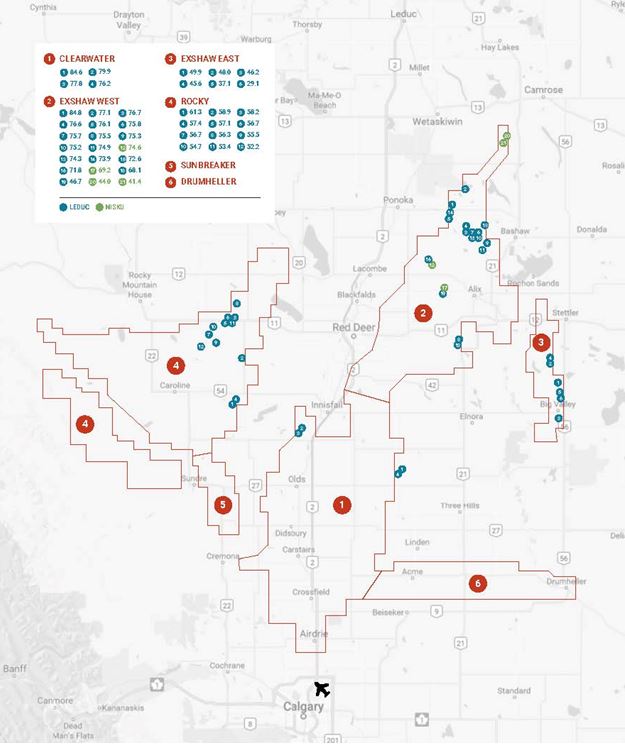E3 Metals Assay Results Confirm Leduc Reef Trend Enriched in Lithium Across a Broader Area Than Originally Tested

E3 METALS CORP. (TSX-V: ETMC, FSE: OU7A, OTC: EEMMF) is pleased to announce that results from the first round of lithium sampling have confirmed historical data ranging from 29.1 mg/L to 84.8 mg/L at actively producing oil and gas wells across a portion of the Company’s Petro-Lithium Project in Alberta. E3 Metals’ sampling program has been completed without the requirement for drilling a well, taking advantage of the existing infrastructure on E3’s permit areas. This has resulted in an very cost-effective sampling and assay program. These results will be used to expedite the completion of the Company’s first National Instrument 43-101 lithium mineral resource, which is expected to be completed before the end of 2017. Â E3 Metals received strong collaborative support from oil and gas operators working in the permit area. This has allowed E3 to confirm lithium concentrations across a broad area, some of which has never previously been tested for lithium. E3 Metals results confirm that the lithium concentrations appear to be consistent throughout the massive Leduc reservoir.
A total of 43 samples were collected during the Company’s initial sampling program, including 39 from within the Leduc Formation (Woodbend Group) and 4 from within the Nisku Formation (Winterburn Group). Both the Nisku and Leduc Formations are Devonian-aged, with the Nisku occurring between 10-200 metres stratigraphically above the Leduc across the sampling area. Devonian Formation stratigraphy for the area can be found in E3 Metals’ Technical Report dated May 18, 2017 Geological Introduction to E3 Metals Corp. Clearwater and Exshaw Lithium-Brine Properties in South Central Alberta, authored by Apex Geoscience Ltd., page 30 (available on SEDAR and on the Company’s website at e3metalscorp.com). The lithium values from this sampling program range from 29.1 mg/L to 84.8 mg/L from within the Leduc Formation and 41.4 mg/L to 74.6 mg/L from within the Nisku Formation.
The Clearwater area samples average approximately 79.6 m/L from 4 samples. Testing is ongoing over the Clearwater area with more results expected in Q4, 2017. In the Rocky area, 12 Leduc wells were sampled with an average of 56.5 mg/L. 17 Leduc wells were tested in Exshaw West, with an average of 73.6 mg/L, and 4 Nisku wells were tested in this same area with an average of 57.3 mg/L. Six Leduc wells were tested in the Exshaw East area, with an average of 42.6 mg/L. There is a general trend of improved lithium enrichment from east to west in Exshaw. The geographical distribution of results is outlined in Table 1.
Table 1: Lithium Results from E3 Metals’ First Round of Sampling
| E3 Metals Project Area | Min Li (mg/L) | Average Li (mg/L) | Max Li (mg/L) | Formation | Number of Wells Sampled |
| Clearwater | 76.2 | 79.6 | 84.6 | Leduc | 4 |
| Exshaw West | 46.7 | 73.6 | 84.8 | Leduc | 17 |
| Exshaw West | 41.4 | 57.3 | 74.6 | Nisku | 4 |
| Exshaw East | 29.1 | 42.6 | 49.9 | Leduc | 6 |
| Rocky | 52.2 | 56.5 | 61.3 | Leduc | 12
|
E3 Metals is continuing to collect samples across the Metallic and Industrial Minerals (MIM) permit area with various operators. The second phase of sampling is expected to continue through Q4 2017 and will enable E3 Metals to complete its initial NI 43-101 mineral resource estimate. The initial resource estimate will cover only a small portion of the Company’s permit areas; additional sampling is planned to increase the size of the resource estimate.

Update: E3’s Alberta Petro-Lithium Project
Petro-Lithium are massive oil and gas reservoirs enriched with lithium in the brine formation water. When the oil is pumped out of these maturing reservoirs by oil and gas operators, ~98% of the fluid that comes with it is water and must be separated from the oil in a separation facility. Not all oil and gas reservoirs contain lithium, which distinguishes E3’s 1.4M acres of permits over the prolific Leduc Reservoir. E3’s permit area has now been tested and shown to contain significant concentrations of lithium in sampled brines. The rapidly growing electric car and power storage industries have increased lithium demand in a supply-constrained growing industry, creating an opportunity for Petro-Lithium to be an important source to the supply chain in the future.
E3 has demonstrated the ability to leverage the existing oil and gas fields’ infrastructure to reduce the exploration costs and development risks compared to conventional exploration for lithium in salars or hard rock deposits. No new drilling and infrastructure building is required for current and proposed exploration. With the trend of decreasing oil and gas production in the area, E3 may be able to acquire infrastructure for minimal cost. While lithium concentrations found in Petro-Lithium projects are generally at the lower end of the current lithium industry production grade curve (around 80 mg/L) it is important to understand that the Leduc Reservoir has the capacity to contain tens of billions of liters of lithium bearing brines with extremely high flow rates.  It is estimated that one well can produce up to 20,000,000 liters of water per day from the reservoir.  These high brine flow rates combined with new direct lithium extraction technologies currently under development by various entities has potential to create a new source of lithium to supply the expanding lithium industry.
